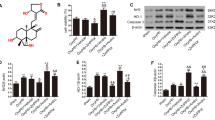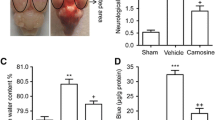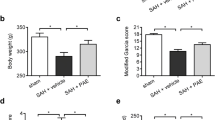Abstract
The present study was undertaken to explore the role of total flavones of Camellia (TFC) on cerebral injury following subarachnoid hemorrhage (SAH) in rats. We showed that the increase of malondialdehyde (MDA) level in brain tissues, leakages of neuron-specifc enolase (NSE) and lactate dehydrogenase (LDH) from brain tissues to serum at 48 h after SAH were significantly blocked by TFC treatment. Besides, TFC treatment could reduce brain edema and the Bax/Bcl-2 ratio in hippocampal tissues at mRNA and protein levels at 48 h after SAH. In addition, and the reduction of neurological scores at 7d after SAH were significantly inhibited by TFC treatment. We next sought to demonstrate the role of TFC on cognitive rehabilitation and the tau phosphorylation in hippocampal tissues at 30d after SAH. Not surprisingly, cognitive dysfunction and the upregulation of tau phosphorylation at Ser262 (p-tau-Ser262) in hippocampal tissues were markedly reduced by TFC treatment. These findings suggested that TFC has protective effect on SAH-induced EBI and subsequent cognitive dysfunction, which may be related to downregulating the Bax/Bcl-2-related apoptosis pathway and inhibition of tau phosphorylation.






Similar content being viewed by others
Abbreviations
- TFC:
-
total flavones of Camellia
- SAH:
-
Subarachnoid hemorrha
- EBI:
-
early brain injur
- MDA:
-
malondialdehyde
- NSE:
-
neuron-specifc enolase
- LDH:
-
lactate dehydrogenase
- CJ:
-
Camellia japonica L.
- ECJ:
-
Camellia japonica L. flower
- MWM:
-
Morris water maze
- RT-PCR:
-
Reverse Transcription Polymerase chain reaction
References
Al-Khindi T, Macdonald RL, Schweizer TA (2010) Cognitive and functional outcome after aneurysmal subarachnoid hemorrhage. Stroke 41:e519-536. https://doi.org/10.1161/STROKEAHA.110.581975
Anto RJ, Mukhopadhyay A, Denning K, Aggarwal BB (2002) Curcumin (diferuloylmethane) induces apoptosis through activation of caspase-8, BID cleavage and cytochrome c release: its suppression by ectopic expression of Bcl-2 and Bcl-xl. Carcinogenesis 23:143–150
Bederson JB, Connolly ES Jr, Batjer HH, Dacey RG, Dion JE, Diringer MN, Duldner JE Jr, Harbaugh RE, Patel AB, Rosenwasser RH, American Heart A (2009) Guidelines for the management of aneurysmal subarachnoid hemorrhage: a statement for healthcare professionals from a special writing group of the Stroke Council. American Heart Association Stroke 40:994–1025. https://doi.org/10.1161/STROKEAHA.108.19139
Chang CP, Huang WT, Cheng BC, Hsu CC, Lin MT (2007) The flavonoid baicalin protects against cerebrovascular dysfunction and brain inflammation in experimental. heatstroke Neuropharmacology 52:1024–1033. https://doi.org/10.1016/j.neuropharm.2006.10.018
Elmaraezy A, Abushouk AI, Saad S, Eltoomy M, Mahmoud O, Hassan HM, Aboelmakarem A, Fotoh AA, Althaher F, Huy NT, Hirayama K (2017) Desmoteplase for Acute Ischemic Stroke: A Systematic Review and Metaanalysis of Randomized Controlled Trials CNS Neurol. Disord Drug Targets 16:789–799. https://doi.org/10.2174/1871527315666161213110104
Fischer D, Mukrasch MD, Biernat J, Bibow S, Blackledge M, Griesinger C, Mandelkow E, Zweckstetter M (2009) Conformational changes specific for pseudophosphorylation at serine 262 selectively impair binding of tau to microtubules. Biochemistry 48:10047–10055. https://doi.org/10.1021/bi901090m
Gao L, Hao J, Niu YY, Tian M, Yang X, Zhu CH, Ding XL, Liu XH, Zhang HR, Liu C, Qin XM, Wu XZ (2016) Network pharmacology dissection of multiscale mechanisms of herbal medicines in stage IV gastric adenocarcinoma treatment . Medicine 95:e4389. https://doi.org/10.1097/MD.0000000000004389
Ghate NB, Hazra B, Sarkar R, Chaudhuri D, Mandal N (2014) Alteration of Bax/Bcl-2 ratio contributes to Terminalia belerica-induced apoptosis in human lung and breast carcinoma. Vitro Cell Dev Biol Anim 50:527–537. https://doi.org/10.1007/s11626-013-9726-x
Hasegawa Y, Suzuki H, Altay O, Zhang JH (2011) Preservation of tropomyosin-related kinase B (TrkB) signaling by sodium orthovanadate attenuates early brain injury after subarachnoid hemorrhage in rats . Stroke 42:477–483. https://doi.org/10.1161/STROKEAHA.110.597344
Heo YM, Shin MS, Lee JM, Kim CJ, Baek SB, Kim KH, Baek SS (2014) Treadmill exercise ameliorates short-term memory disturbance in scopolamine-induced amnesia rats . Int Neurourol J 18:16–22. https://doi.org/10.5213/inj.2014.18.1.16
Hou X, He C, Jin Q, Niu Q, Ren G, Cheng H (2017) Novel Mutation of the NOTCH3 Gene in a Chinese Pedigree with CADASIL CNS Neurol. Disord Drug Targets 16:30–35. https://doi.org/10.2174/1871527315666161024125952
Joswig H, Korte W, Fruh S, Epprecht L, Hildebrandt G, Fournier JY, Stienen MN (2018) Neurodegenerative cerebrospinal fluid biomarkers tau and amyloid beta predict functional, quality of life, and neuropsychological outcomes after aneurysmal subarachnoid hemorrhage. Neurosurg Rev 41:605–614. https://doi.org/10.1007/s10143-017-0900-6
Jurado-Coronel JC, Avila-Rodriguez M, Echeverria V, Hidalgo OA, Gonzalez J, Aliev G, Barreto GE (2016) Implication of Green Tea as a Possible Therapeutic Approach for Parkinson Disease CNS Neurol. Disord Drug Targets 15:292–300
Kanavaki A, Spengos K, Moraki M, Delaporta P, Kariyannis C, Papassotiriou I, Kattamis A (2017) Serum Levels of S100b and NSE Proteins in Patients with Non-Transfusion-Dependent Thalassemia as Biomarkers of Brain Ischemia and Cerebral Vasculopathy. Int J Mol Sci 18. https://doi.org/10.3390/ijms18122724
Kumar GP, Khanum F (2012) Neuroprotective potential of phytochemicals. Pharmacogn Rev 6:81–90. https://doi.org/10.4103/0973-7847.99898
Lan X, Han X, Li Q, Li Q, Gao Y, Cheng T, Wan J, Zhu W, Wang J (2017) Pinocembrin protects hemorrhagic brain primarily by inhibiting toll-like receptor 4 and reducing M1 phenotype microglia . Brain Behav Immun 61:326–339. https://doi.org/10.1016/j.bbi.2016.12.012
Liang G, Shi B, Luo W, Yang J (2015) The protective effect of caffeic acid on global cerebral ischemia-reperfusion injury in rats . Behav Brain Funct 11:18. https://doi.org/10.1186/s12993-015-0064-x
Liu ZW, Zhang T, Yang Z (2007) Involvement of nitric oxide in spatial memory deficits in status epilepticus rats. Neurochem Res 32:1875–1883. https://doi.org/10.1007/s11064-007-9374-1
Lu WZ, Wen JY (2019) The role of total flavone of Camellia on cerebrovascular vasopasm after subarachnoid hemorrhage in rats. Pharmacogn Mag 15:433–437. https://doi.org/10.1590/0004-282X20180146
Lu W, Wang H, Chu S (2017) Protective effect of extract of Camellia japonica L on hippocampal neurons subjected to anoxia-reoxygenation injury. J Huainan Vocat Tech Coll 17:3
Lu W, Xv L, Wen J (2019) Protective effect of extract of the Camellia japonica L. on cerebral ischemia-reperfusion injury in rats . Arq Neuropsiquiatr 77:39–46. https://doi.org/10.4103/pm.pm_593_18
Mingyu, Huang SL (2012) Experimental study on the effect of total of Flacone Con Anti-tumor guide of China Medicine 10:3–5
Mizutani T, Masaki H (2014) Anti-photoaging capability of antioxidant extract from Camellia japonica leaf. Exp Dermatol 23(Suppl 1):23–26. https://doi.org/10.1111/exd.12395
Onodera K, Hanashiro K, Yasumoto T (2006) Camellianoside, a novel antioxidant glycoside from the leaves of Camellia japonica. Biosci Biotechnol Biochem 70:1995–1998. https://doi.org/10.1271/bbb.60112
Park SH, Shim BS, Yoon JS, Lee HH, Lee HW, Yoo SB, Wi AJ, Park WS, Kim HJ, Kim DW, Oak MH (2015) Vascular protective effect of an ethanol extract of Camellia japonica fruit: Endothelium-dependent relaxation of coronary artery and reduction of smooth muscle cell migration. Oxidative Med Cell Longev 6309565. https://doi.org/10.1155/2016/6309565
Qu S, Liu W, Yang H, Wang Z, Yang Y, Liu F, Du K, He S, Luan Z (2017) Analysis of adverse events related to 720 cases of neural progenitor cell transplantation . CNS Neurol Disord Drug Targets 16:210–216. https://doi.org/10.2174/1871527315666161207160258
Sabri M, Kawashima A, Ai J, Macdonald RL (2008) Neuronal and astrocytic apoptosis after subarachnoid hemorrhage: a possible cause for poor prognosis. Brain Res 1238:163–171. https://doi.org/10.1016/j.brainres.2008.08.031
Sehba FA, Hou J, Pluta RM, Zhang JH (2012) The importance of early brain injury after subarachnoid hemorrhage. Prog Neurobiol 97:14–37. https://doi.org/10.1016/j.pneurobio.2012.02.003
Shi X, Fu Y, Zhang S, Ding H, Chen J (2017) Baicalin attenuates subarachnoid hemorrhagic brain injury by modulating blood-brain barrier disruption, inflammation, and oxidative damage in mice. Oxidative Med Cell Longev 1401790. https://doi.org/10.1155/2017/1401790
Su Z, Han D, Sun B, Qiu J, Li Y, Li M, Zhang T, Yang Z (2009) Heat stress preconditioning improves cognitive outcome after diffuse axonal injury in rats. J Neurotrauma 26:1695–1706. https://doi.org/10.1089/neu.2008.0519
Toklu HZ, Yang Z, Oktay S, Sakarya Y, Kirichenko N, Matheny MK, Muller-Delp J, Strang K, Scarpace PJ, Wang KKW, Tumer N (2018) Overpressure blast injury-induced oxidative stress and neuroinflammation response in rat frontal cortex and cerebellum. Behav Brain Res 340:14–22. https://doi.org/10.1016/j.bbr.2017.04.025
Wang Z, Wu L, You W, Ji C, Chen G (2013) Melatonin alleviates secondary brain damage and neurobehavioral dysfunction after experimental subarachnoid hemorrhage: possible involvement of TLR4-mediated inflammatory pathway. J Pineal Res 55:399–408. https://doi.org/10.1016/j.biopha.2019.108692
Wang J, Wang A, He H, She X, He Y, Li S, Liu L, Luo T, Huang N, Luo H, Zou K (2019) Trametenolic acid B protects against cerebral ischemia and reperfusion injury through modulation of microRNA-10a and PI3K/Akt/mTOR signaling pathways . Biomed Pharmacother = Biomedecine Pharmacotherapie 112:108692. https://doi.org/10.1111/jpi.12087
Wen J, Behloul N, Dai X, Dong C, Liang J, Zhang M, Shi C, Meng J (2016) Immunogenicity difference between two hepatitis E vaccines derived from genotype 1 and 4. Antivir Res 128:36–42. https://doi.org/10.1016/j.antiviral.2016.02.002
Wen JY, Gao SS, Chen FL, Chen S, Wang M, Chen ZW (2019) Role of CSE-Produced H2S on Cerebrovascular Relaxation via RhoA-ROCK Inhibition and Cerebral Ischemia-Reperfusion Injury in Mice. ACS Chem Neurosci 10:1565–1574. https://doi.org/10.1021/acschemneuro.8b00533
Woo Y, Lee H, Jeong YS, Shin GY, Shin JG, Kim JS, Oh J (2017) Antioxidant potential of selected Korean edible plant extracts. BioMed Res Int 7695605. https://doi.org/10.1155/2017/7695605
Yu YP, Chi XL, Liu LJ (2014) A hypothesis: hydrogen sulfide might be neuroprotective against subarachnoid hemorrhage induced brain injury. TheScientificWorldJOURNAL 432318. https://doi.org/10.1155/2014/432318
Yuksel S, Tosun YB, Cahill J, Solaroglu I (2012) Early brain injury following aneurysmal subarachnoid hemorrhage: emphasis on cellular apoptosis. Turk Neurosurg 22:529–533. https://doi.org/10.1016/j.jep.2013.11.018
Zhu L, Zhang L, Zhan L, Lu X, Peng J, Liang L, Liu Y, Zheng L, Zhang F, Liu Q (2014) The effects of Zibu Piyin Recipe components on scopolamine-induced learning and memory impairment in the mouse. J Ethnopharmacol 151:576–582. https://doi.org/10.5137/1019-5149.JTN.5731-12.1
Funding
This study was supported by Grants for Scientific Research of BSKY (No. XJ201612) from Anhui Medical University and from Natural Science Foundation of Hefei Technology College (No. 201914KJA020).
Author information
Authors and Affiliations
Contributions
Wen JY: Participated in research design and writing of the manuscript; Lu WZ: Participated in experiments and data analysis.
Corresponding author
Ethics declarations
All animal experiments were reviewed and approved by the Ethics Review Committee of Anhui Medical University, which comply with the Guide for the Care and Use of laboratory Animals published by the US National Institutes of Health (NIH publication no. 85 − 23, revised 2011).
Conflict of interest
The authors have no conflicts of interest to disclose.
Additional information
Publisher's note
Springer Nature remains neutral with regard to jurisdictional claims in published maps and institutional affiliations.
Rights and permissions
About this article
Cite this article
Lu, W., Wen, J. Neuroprotective roles of total flavones of Camellia on early brain injury andcognitive dysfunction following subarachnoid hemorrhage in rats. Metab Brain Dis 35, 775–783 (2020). https://doi.org/10.1007/s11011-020-00567-6
Received:
Accepted:
Published:
Issue Date:
DOI: https://doi.org/10.1007/s11011-020-00567-6




